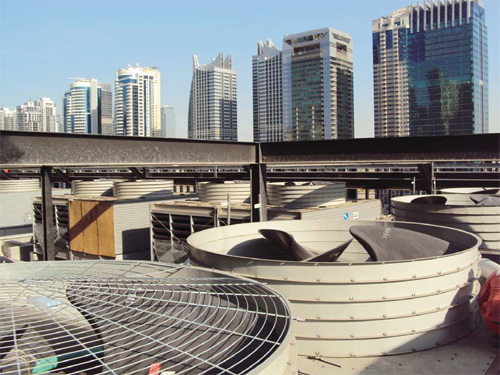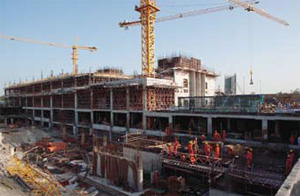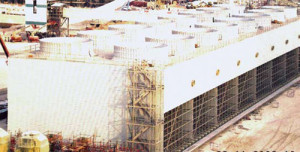Jose Franco writes about the need for manufacturers to modify their heat-removal devices in tune with present and future requirements
Jose Franco writes about the need for manufacturers to modify their heat-removal devices in tune with present and future requirements.

Cooling towers with ultra low-noise fan installed by Baltimore Aircoil Gulf at Emaar Plaza Baltimore Aircoil Gulf
Customisation is the now the name of the game when it comes to cooling towers. The market calls for various innovations in these heatremoval devices, which send process-heat waste into the atmosphere. Manufacturers should, therefore, incorporate into their products a number of features like noise attenuation systems, hybrid towers for low plume and optimal tower sizing with respect to space availability.

Jeevan Joy
These needed modifications to creating specialised cooling towers are necessary, says Jeevan Joy, the managing director of Spig Middle East, since large-capacity plants for district cooling call for customisation. And the Gulf region has great demand for cooling towers, especially in the power, petrochemical, process and district-cooling industries. Joy remarks, “The largest demand is from the power and petrochemical sectors.”
Frank van Leemput, the area sales manager of Dubai based Baltimore Aircoil Gulf, sees in the future hybrid cooling towers which minimise the use of water, are easy to maintain and have more features against Legionnaires Disease (LD). He says manufacturers are currently busy finding ways of installing cooling towers indoors and in “difficult” space layouts, reducing noise emission by these devices and improving their safety and maintenance as well as coming up with LEED-driven solutions.
“At the product level,” van Leemput says, “there is now interest for ‘silent’ solutions – as some areas are fully built-up and residential towers are close to each other – and ‘enhanced reliability’ solutions like closed-circuit coolers which protect the chiller against sand and dust.”
While a number of district cooling projects have been cancelled due to the economic slowdown, van Leemput says the situation in which buildings are forced to find places within themselves for their own HVAC plants presents some opportunities. Consider, for instance, a project that needs modular or mobile chiller plants, and the demand for versatile products.
“Cooling towers are now to be fitted in a building which was not foreseen to be equipped with cooling towers,” says van Leemput, “and the roof is very often not an option.” He adds, “At a geographical level there is a shift in market activity – that is, cash-rich and areas filled with government projects are now taking the forefront, such as in Abu Dhabi, Qatar and Saudi Arabia.”
A hybrid cooling tower, which relies on both water and air to cool the working fluid, is being introduced in the market, notes Rami Al Khalil, the Abu Dhabi-based sales manager at Morex, which has for 18 years served as a full-service manufacturerrepresentative company for the HVAC&R industry in the Middle East. He says there are big tenders involving various projects in Saudi Arabia, such as the King Abdulla Financial District, as well as in Qatar and the UAE.
Cooling towers, whose common applications include cooling the circulating water used in oil refineries, chemical plants, power stations and building cooling, are covered under ‘L8’, a code of practice approved by the international community to control the spread of LD. The towers vary in size from small roof-top units to very large hyperboloid structures of up to 200 metres in height and 100 metres in diameter, or rectangular structures that can be over 40 metres tall and 80 metres long. Smaller towers are built in the factory while the larger ones are constructed on site.
Brought about by bacteria in aerosols or water droplets which people inhale, LD is a potentially fatal form of pneumonia. L8, which applies also to hot and cold water systems and evaporative condensers, calls for risk assessment of these devices, including cooling towers, and the appointment of a manager, rather than a technician, to be in charge of such. It also provides for ongoing review and reassessment of exposure to the bacteria, called legionella, and the development, implementation and management of a risk-minimisation programme.
Anti-LD legislations exist in most countries, along with measures for energyefficient and green solutions in the HVAC&R industry, van Leemput stresses, but are not always implemented. “This makes it more difficult for manufacturers who live up to international standards and code,” he says, especially now that cheaper solutions have become the focus due to the economic crisis. “LEED-driven projects will, however, place a premium on these solutions.”

The Bridge Way Hotel project in Abu Dhabi, where Morex supplied
Companies also have started offering turnkey solutions for district cooling projects, Al Khalil says, and they maintain these projects for a longer period as part of a strategy to improve customer service and package offering. Another strategy being used by some companies nowadays is the build-operate-transfer (BOT) scheme, which addresses mainly the high costs of a district cooling plant and, eventually, the transfer of technology.
“These are manufacturers which have ‘total concept’ offering – that is, the unit plus service,” says van Leemput. After-sales service should be formalised via contracts, as cooling towers need to be maintained by factory-trained technicians, not by those unfamiliar with the products. The spare parts should be genuine, as well, van Leemput adds, in order to ensure good performance and longer lifespan.
Spig Middle East brings its customer service further to include online monitoring for preventive maintenance, and a global reach for trouble-free operation and maintenance of cooling towers. Joy remarks, “We also have online monitoring solutions which we are offering our customers to have an effective, preventive maintenance by keeping online track of the condition of rotating equipment, and also to evaluate the performance of the cooling towers.”
Government projects, such as schools, hospitals and administrative complexes in Saudi Arabia, will mainly drive the demand for cooling towers and other related components within the HVAC&R systems, van Leemput says. Other economies that will dominate the market are Qatar and Abu Dhabi, he adds, citing good economic situation which is much better compared to that in, say, European states.
The various ongoing and planned developments in the Middle East will require millions of tonnes of refrigeration for the next 5-10 years, the beneficiary of which will mainly be the district cooling sector and the industrial and commercial projects. This has been pointed out by Al Khalil, saying that companies may take advantage of the growing markets, such as Saudi Arabia, by teaming up with local suppliers or representatives.

Spig Middle East’s 60,000 TR district-cooling plant at Jumeirah Beach Residence
This is echoed by Joy, who emphasises the big potential for cooling towers in Saudi Arabia, which is having a flurry of gigantic development projects involving universities, hospitals and residential communities. Large requirements from the petrochemical, power, process and industrial segments also make the Saudi market more lucrative.
What Joy wants to see realise is manufacturers working with local partners in promoting the advantages and merits of using watercooled systems in large tonnage applications like district cooling. He stresses that the benefits of using seawater-cooling towers, considering that most of the petrochemical, power and process plants are close to the sea and need large capacities of water flow to cool the process. “The clients need to be made aware that the capacity of existing intake channels is diminishing, and environmental guidelines need to be strictly adhered to,” he adds.
Spig Middle East is executing some prestigious projects in various developments across the Gulf region, such as the Dubai Motor City, New Doha International Airport, SIDRA Medical Hospital and Research Centre (in Doha) and Hadeed District Cooling Plant (in Saudi Arabia). “We are awaiting orders for a couple of major districtcooling projects, which are in the pipeline,” says Joy, “and we are also awaiting some big orders from the petrochemical sector in Saudi Arabia and Qatar.”
Baltimore Aircoil Gulf, which focuses mainly on Abu Dhabi and Qatar, has a number of ongoing projects in the UAE. These include three closed-circuit coolers at Ramada Hotel, in Dubai; five open cooling towers at Wahat Hilli Mall, in Al Ain; 10 open cooling towers with ultra lownoise fan at Marina Plaza Plot (Dubai) and four open cooling towers forced draft with double attenuation package at Landmark (Abu Dhabi).
While Baltimore does not disclose its spending on research and development, Spig says it allots 20% of its annual revenue for R&D and programmes on corporate social responsibility, or CSR. Joy says that Spig, which places at $20 million its estimated turnover in the Gulf for this year, has always focused on technology enhancement and innovations in cooling systems.
This move is reflected in the number of patents and certificates that Spig has received from various accredited bodies for its excellent components and innovative manufacturing techniques. Joy proudly remarks, “We still strive to keep on moving forward and bring out the best for our client, so that they could benefit from powerand water-saving, with utmost considerations to environmental aspects.”
Copyright © 2006-2025 - CPI Industry. All rights reserved.